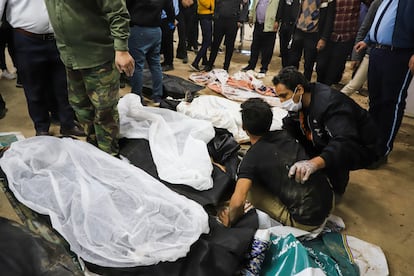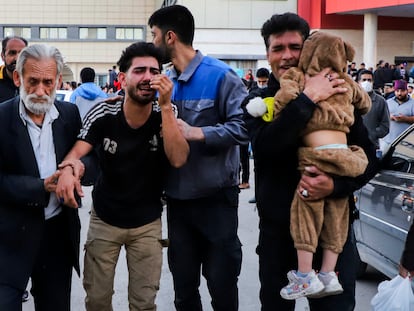Islamic State claims responsibility for the attack that killed more than 80 people in Iran
An Iranian source close to the investigation says that the blasts were carried out by suicide bombers, despite earlier talk of remote-controlled bombs having been used. Some Iranian leaders had initially blamed Israel


The Islamic State (ISIS) claimed responsibility on Thursday for the attack in the Iranian city of Kerman that the day before killed more than 80 people and wounded some 300 during a ceremony to commemorate the fourth anniversary of the assassination of Qassem Soleimani, who was killed in 2020 in a U.S. drone strike. The extremist group made the announcement through a message on a Telegram channel it uses to transmit propaganda, in which it explained that the two explosions that took place at the gathering were carried out by suicide bombers.
“The two martyrs Omar al-Muwahid and Saif Allah al-Mujahid — may God Almighty accept them — set out towards a large gathering of polytheist Shiites, near the grave of their dead leader Qassem Soleimani in the city of Kerman,” the group said in its statement, in which it identified the two attackers. The Islamic State does not consider Shiites to be true Muslims and has attacked them on numerous occasions in Iran, Iraq, Syria and Afghanistan. “They detonated their explosive belts in the middle of the crowd, killing and wounding more than 300 polytheist Shiites.”
A source close to the investigation of the attacks quoted by the state news agency IRNA explained that it is likely that the attack was perpetrated by suicide bombers, despite the fact that hours after the attack authorities had assured that remote-controlled bombs had been used. “After examining the clues and evidence, including security camera footage, all indications are that the first explosion was the result of a suicide attack. The suicide bomber in the first incident was a man who was completely dismembered as a result of the blast,” the source explained. “The second explosion is still under investigation, but it is likely that it was also a suicide attack,” he added.
The first explosion occurred at 2:45 p.m. local time and the second, ten minutes later, in a different but not very distant location. Both occurred before the security checkpoints guarding the accesses to the cemetery where Soleimani is buried, where thousands of people had come to pay tribute to the Iranian general.
Wednesday’s bombings were the deadliest attack suffered by the Islamic Republic since its founding in 1979. Although initially authorities believed over 100 people had been killed, this morning the Interior Minister lowered the death toll to 84. The reason for these changes is that there were many duplicate names. He warned, however, that the death toll could rise, since among the injured who are still hospitalized there are several in critical condition.
Ali Vaez, director of the Iran program at the International Crisis Group, believes that the attack “fits the MO of ISIS.” “There have been similar attacks against religious and military targets in the past. The [Iranian] border with Afghanistan is porous, easy for ISKP [ISIS’s arm in Afghanistan] to enter and pull this off against soft targets,” he wrote on X. “The Kerman attack has once again highlighted Iran’s vulnerability and the government’s failure in providing security. While the security forces seem adept at harassing women not wearing Hijab, they fail to save their lives and protect them against terrorism,” he concluded.
Iran has begun to reinforce security on its eastern border. “There are points on the border with Afghanistan and Pakistan that are a priority,” acknowledged the country’s Interior Minister, who has gone to the province of the attack, where, he said, security forces have “restored normality.”
The Iranian Supreme National Security Council held an extraordinary meeting on Thursday and demanded “intelligence agencies” to “promptly trace the leads” and “identify the mercenaries” who committed the massacre, as well as to clarify “the role of corrupt minds who, in different parts of the world, support terrorism.”
In the hours after the attack, several Iranian leaders pointed to Israel and the United States as the alleged perpetrators. Israel has carried out numerous attacks on Iranian soil, although mostly targeting military and nuclear scientists. However, given the tension in the region following the invasion of Gaza and the assassination by drone of Hamas’ deputy leader, which, according to various sources, was carried out by Israel the day before, it was assumed in the Islamic Republic that this was a strategy by Israel to drag Iran into a regional conflict.
Also on Thursday, the Iranian newspaper Kayhan, known for its closeness to Supreme Leader Ali Khamenei, attributed the Kerman attack to Israel and called for “immediate action.” However, the night after the attack, a U.S. State Department spokesman said his country had nothing to do with the attack and asserted that Israel was not involved either. According to The Wall Street Journal, the Israeli government has reportedly conveyed to several allied countries that it was not involved in the bombings.
Sign up for our weekly newsletter to get more English-language news coverage from EL PAÍS USA Edition
Tu suscripción se está usando en otro dispositivo
¿Quieres añadir otro usuario a tu suscripción?
Si continúas leyendo en este dispositivo, no se podrá leer en el otro.
FlechaTu suscripción se está usando en otro dispositivo y solo puedes acceder a EL PAÍS desde un dispositivo a la vez.
Si quieres compartir tu cuenta, cambia tu suscripción a la modalidad Premium, así podrás añadir otro usuario. Cada uno accederá con su propia cuenta de email, lo que os permitirá personalizar vuestra experiencia en EL PAÍS.
¿Tienes una suscripción de empresa? Accede aquí para contratar más cuentas.
En el caso de no saber quién está usando tu cuenta, te recomendamos cambiar tu contraseña aquí.
Si decides continuar compartiendo tu cuenta, este mensaje se mostrará en tu dispositivo y en el de la otra persona que está usando tu cuenta de forma indefinida, afectando a tu experiencia de lectura. Puedes consultar aquí los términos y condiciones de la suscripción digital.
More information
Archived In
Últimas noticias
Most viewed
- Sinaloa Cartel war is taking its toll on Los Chapitos
- Oona Chaplin: ‘I told James Cameron that I was living in a treehouse and starting a permaculture project with a friend’
- Reinhard Genzel, Nobel laureate in physics: ‘One-minute videos will never give you the truth’
- Why the price of coffee has skyrocketed: from Brazilian plantations to specialty coffee houses
- Silver prices are going crazy: This is what’s fueling the rally










































